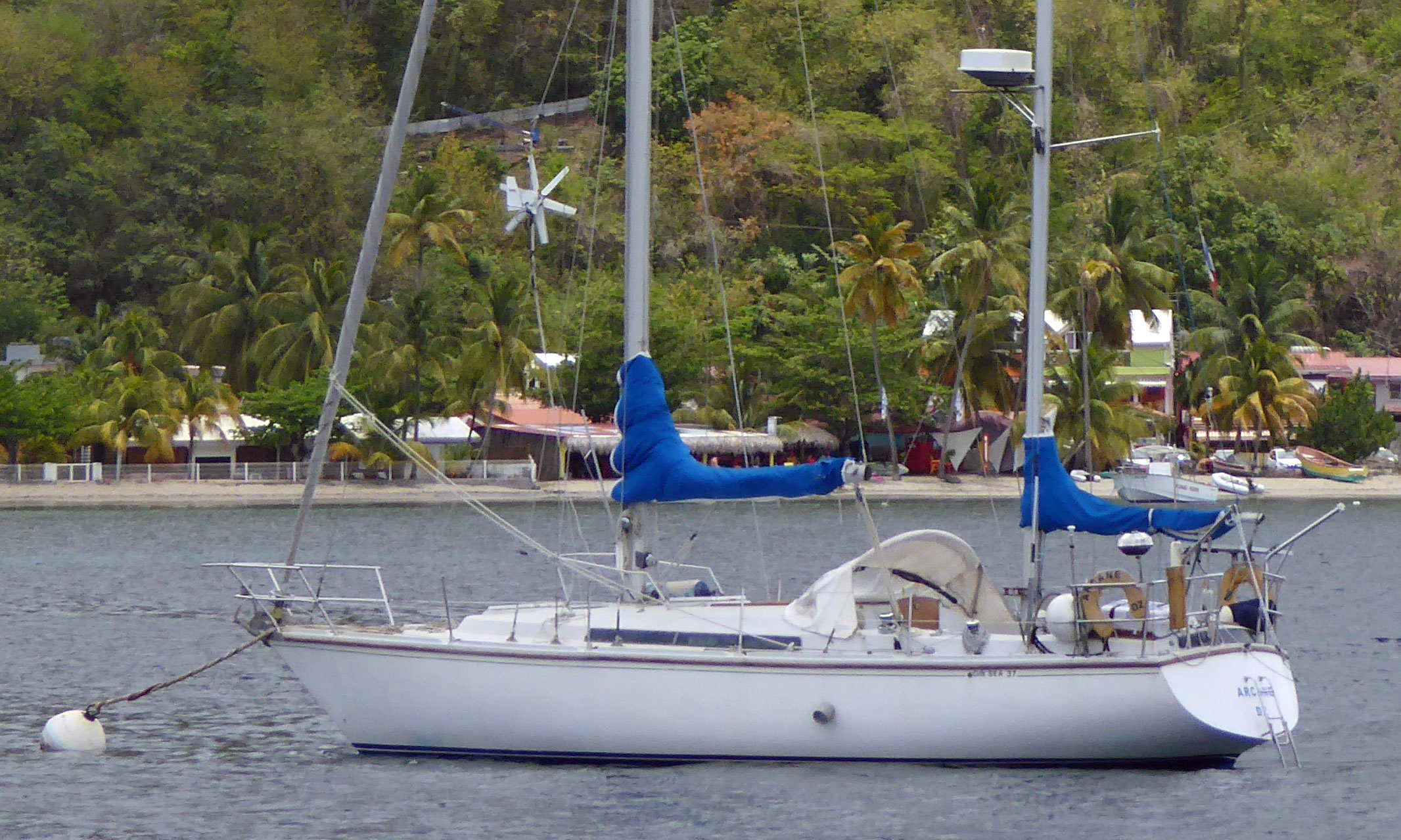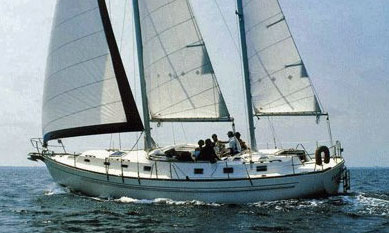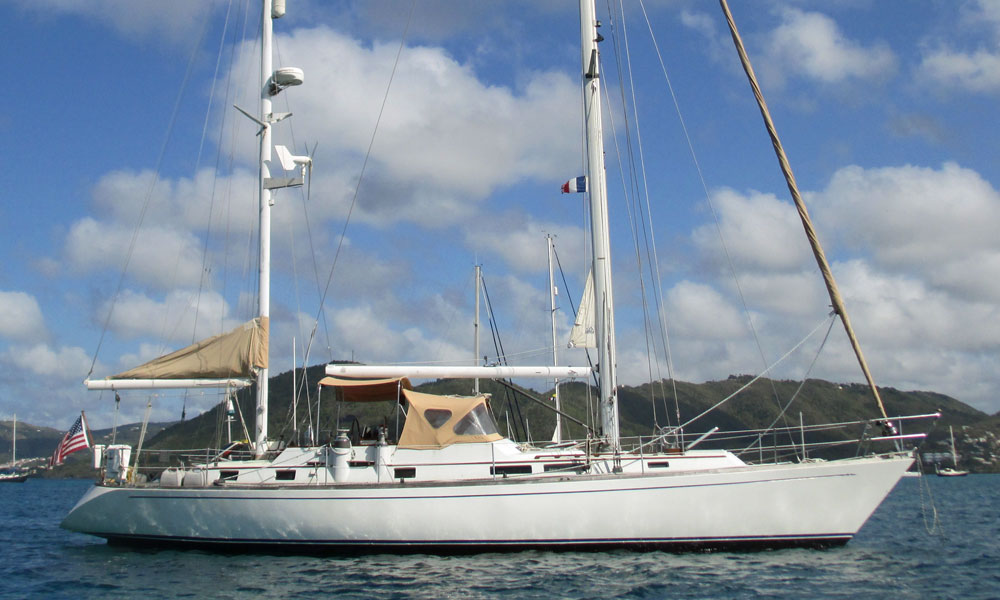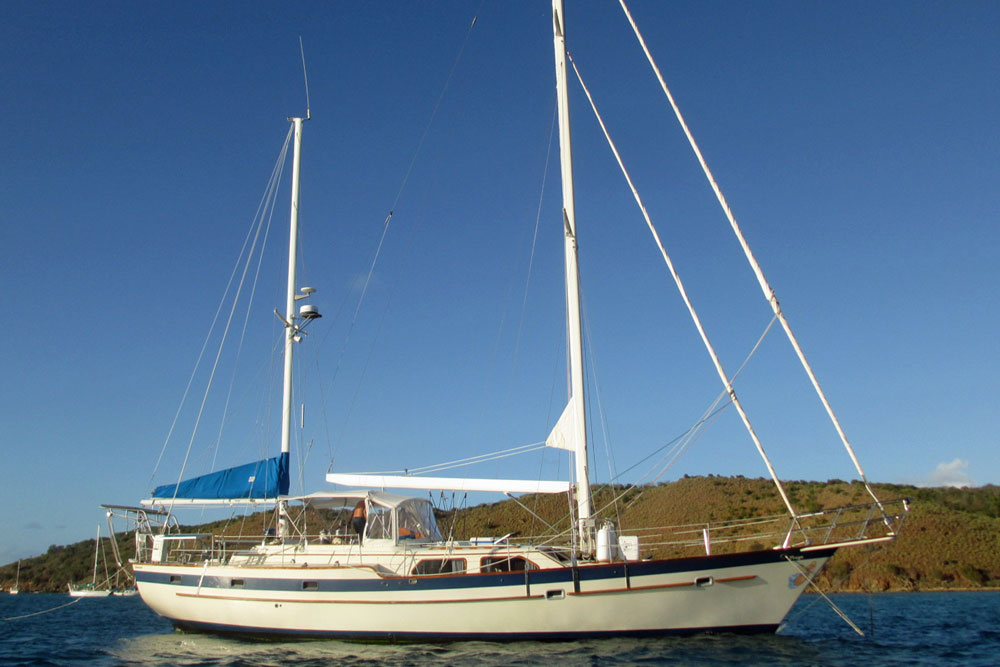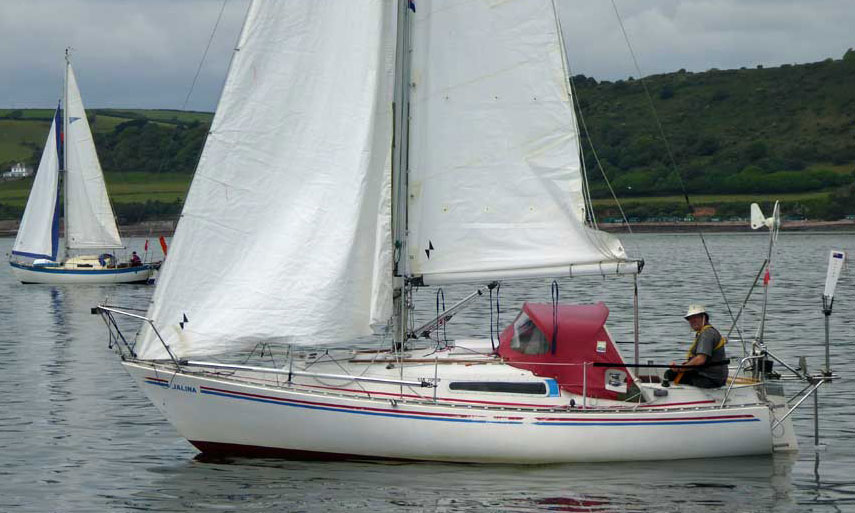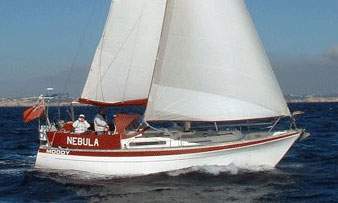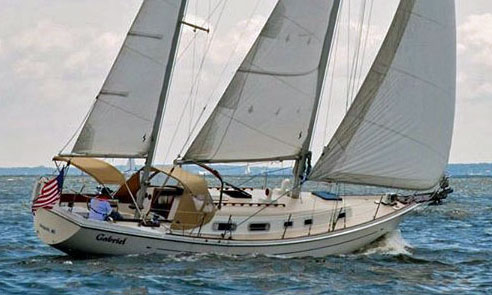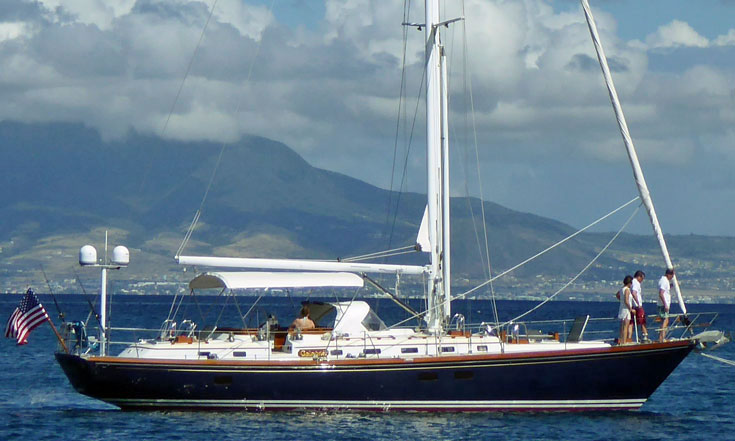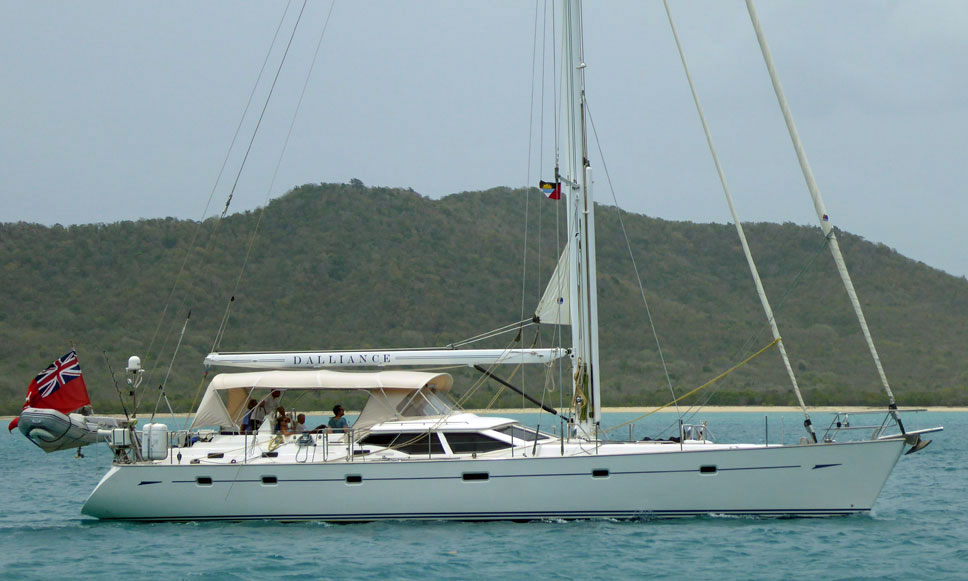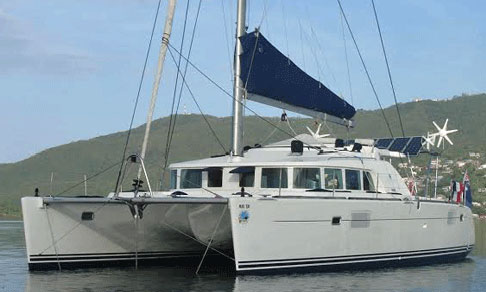- Home
- Types of Sailboats
- Ketch Sailboat
Does a Ketch Sailboat Make a Good Cruising Boat?
A ketch sailboat most certainly does make a good cruising boat! With the total sail area split between 3 sails (or 4 in the staysail ketch version shown below), sail handling is easier for a shorthanded crew than it would be on a sloop of similar size.
The distribution not only lightens the physical workload but also offers practical flexibility in how you manage the sails—which can be a lifesaver when cruising in unpredictable conditions.
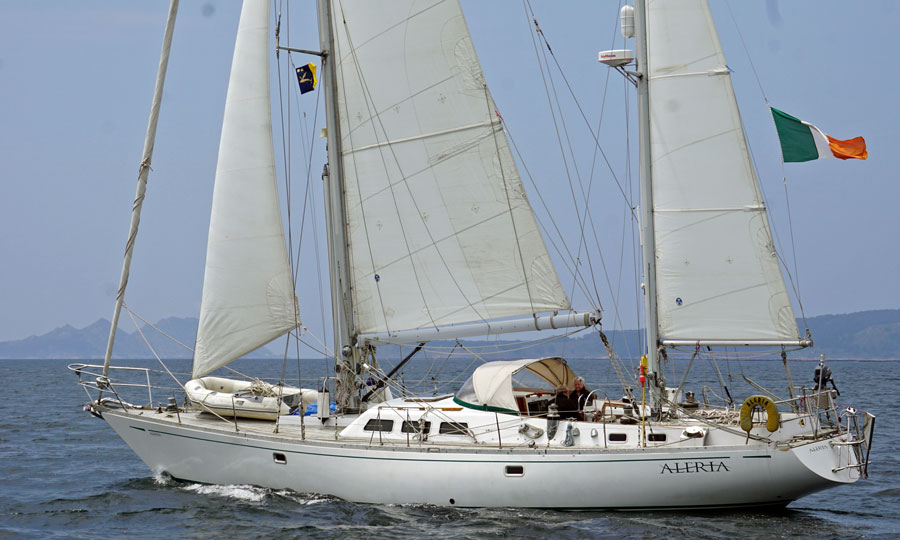 Some ketches, particularly larger ones like this one sport a cutter rig and are then known as a 'staysail ketch'.
Many thanks to Alex and Daria Blackwell for this great pic of their Bowman 57 'Aleria'.
Some ketches, particularly larger ones like this one sport a cutter rig and are then known as a 'staysail ketch'.
Many thanks to Alex and Daria Blackwell for this great pic of their Bowman 57 'Aleria'.But could it be a Yawl?
It's easy to confuse a ketch sailboat with a yawl so perhaps we should clear that up before we go any further. Both are two-masted rigs with a mainmast foremost and a smaller mizzen mast aft.
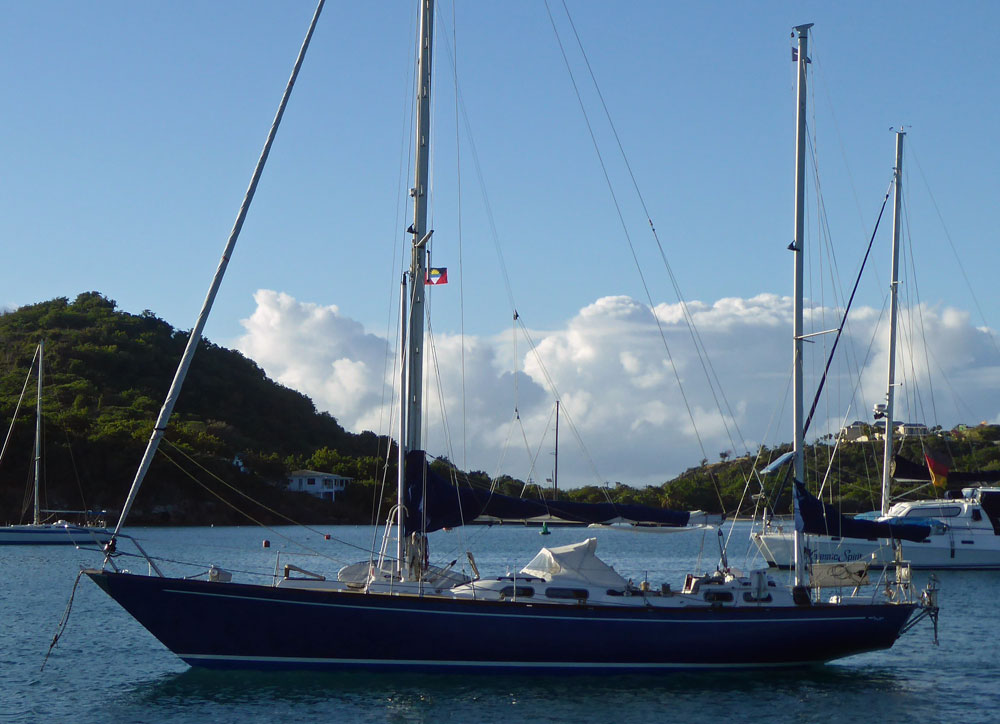 Compare this Bowman 46 yawl with the Bowman 57 ketch above
Compare this Bowman 46 yawl with the Bowman 57 ketch aboveIt's generally accepted that the difference between the two types comes down to the location of the mast in relation to the rudder post. In a yawl the mizzen is aft of the rudder post and in the ketch, it's forward.
But the real difference is one of purpose. The mizzen on a yawl is intended to help trim the boat, in capable hands giving them the ability to follow a compass course despite minor wind shifts.
This was a very handy feature in the days when commercial fishing was done under sail, but these days efficient autopilots and navigation aids have made this less important and the yawl has generally fallen out of favour.
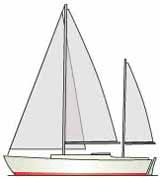 Ketch: Mizzen mast ahead of the rudder post
Ketch: Mizzen mast ahead of the rudder post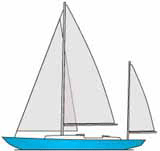 Yawl: Mizzen mast aft of the rudder post
Yawl: Mizzen mast aft of the rudder postThe Mizzen Sail on a Yawl or Ketch Sailboat
The mizzen sail of a ketch is larger than that of a yawl and is there to add drive. And so it does - off the wind.
On the wind though, the mizzen is likely to add nothing but drag, being back-winded most of the time by the mainsail.
In these conditions the mizzen sail may as well be dropped, at which point the ketch becomes in effect an under-canvassed sloop.
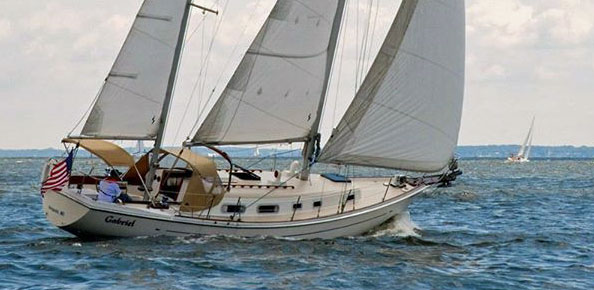 An Allied Princess 36 Ketch makes good progress to windward
An Allied Princess 36 Ketch makes good progress to windwardThe Mizzen Staysail
Off the wind a ketch is at its most efficient, particularly so if cutter rigged and with a mizzen staysail set.
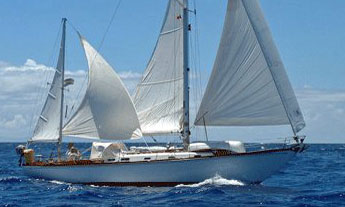 This mizzen staysail is earning its keep!
This mizzen staysail is earning its keep!That's the sail set between the head of the mizzen mast and the foot of the main mast, as on the Hinkley 42 yawl shown here.
But all the additional hardware - mizzen mast, sails, winches, standing and running rigging - comes with a considerable cost burden.
One of the greatest strengths of the ketch is how it divides the sail area among several smaller sails. In practice, this means:
- Effortless Reefing and Trim Adjustments: When sudden gusts hit, you can reef the mainsail quickly or even drop the mizzen without upsetting the boat’s balance.
- Flexible Sail Configurations: In moderate conditions you might opt to sail just the jib and mizzen, or even adjust the mainsail trim. This flexibility makes managing a voyage with a small crew less stressful.
The Performance Side of Things
When it comes to performance, a ketch’s distributed sail plan offers several noteworthy benefits:
- Enhanced Balance and Handling: By spreading out the sail area, you manipulate the centre of effort more easily. Although ketches might not point as high into the wind as a finely tuned sloop, they excel on a broad reach thanks to the additional drive provided by the mizzen (especially when fitted with staysails).
- Optimized for Varying Conditions: Off the wind the ketch’s design is particularly efficient. On the other hand, if sailing close-hauled, you have the option to drop the mizzen and run with a reduced, more manageable sail plan.
- Visual Guides and Practical Charts: Many modern ketch models even come with performance charts and decision flowcharts (like “if wind speed exceeds X, then reef mainsail and drop mizzen”) that help owners fine-tune sail trim for optimal performance.
The Triatic Backstay
Although you'll see many ketch sailboats with a triatic backstay tensioned between the two mastheads, each mast should be stayed individually.
Whilst this stay is ideally placed to act as an insulated SSB radio aerial, in the event of the loss of one mast it's almost guaranteed to result in the loss of the other.
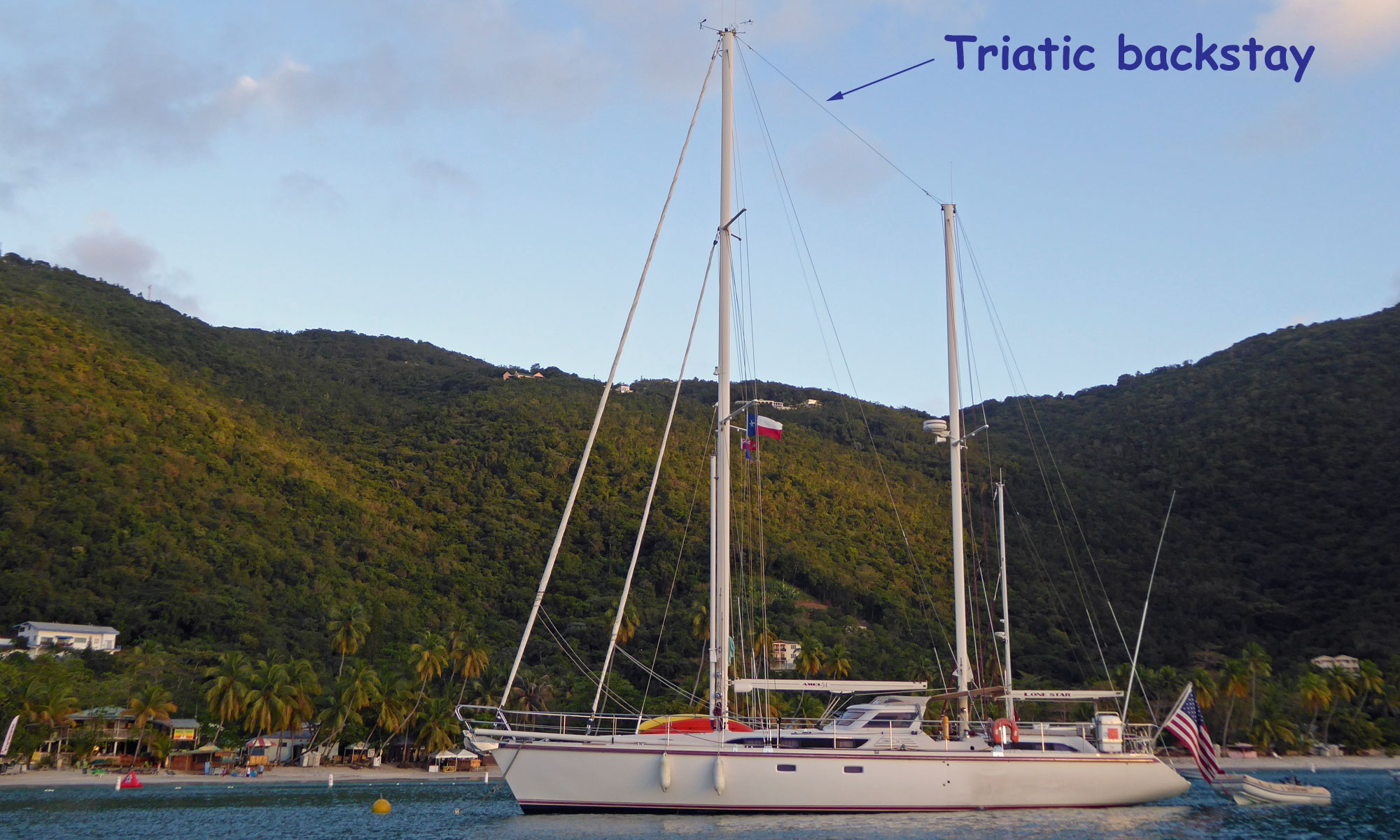 This Amel 54 cutter-rigged ketch sports a triatic backstay between the main and mizzen masts
This Amel 54 cutter-rigged ketch sports a triatic backstay between the main and mizzen mastsA staysail ketch like the Amel 54 shown above will carry the following suit of working sails:
- jib;
- staysail;
- mainsail;
- mizzen staysail;
- mizzen;
A cruising sloop of a similar size has only two sails to make up the same sail area, which would be considerably more difficult for a short-handed crew to handle.
So, in answer to the original question, although they're not the best choice for windward sailing, the ketch can make an ideal cruising sailboat.
Lastly, the mizzen mast on a ketch sailboat provides an ideal place to mount your radar scanner and wind generator. And as one old sea-dog once told me, a convenient thing to lean against when you're smoking your pipe.
A Few Examples of Ketch Rigged Cruising Boats
Cruisers' Questions...
What are the Pros & Cons of a Ketch?
What are the Pros & Cons of a Ketch?
Pros:
- Spread of Sail: Ketches have their sail area distributed over a higher number of sails, which means the size of each sail is generally smaller when compared to a sloop. This is useful when conditions are rough, as it's easier and safer to handle smaller sails.
- Rig Options: The ability to switch between sail configurations makes ketches versatile. You can use only the mizzen and jib in a strong wind, only the main in moderate wind, and all sails in a light wind.
- Downwind Efficiency: Ketches tend to perform well when sailing downwind, as the mizzen sail helps to catch additional wind.
- Balance: The mizzen sail aids in stabilizing the boat which is useful when minimizing roll at anchor and helps balance the boat under sail.
- Emergency Steering: The mizzen sail can be used for emergency steering if the rudder or main steering system becomes damaged.
Cons:
- Cost: Ketches often cost more due to the additional rigging and hardware needed for the extra mast and extra sails.
- Maintenance: More rigging and more sails also mean more maintenance. Ketches may require more effort and cost to uphold.
- Windward Performance: Ketches are often outperformed by sloops or cutters when sailing upwind.
- Maneuverability: The extra mast can complicate tacking and jibing maneuvers, particularly in heavier winds.
- Space Occupancy: The mizzen mast in a ketch can limit the space available in the cockpit or aft areas.
It's important to note the pros and cons can vary based on the specific design of the ketch. Certain designs may mitigate some of the cons, and other pros may become more apparent in certain types of conditions.
What are the ideal sailing conditions and environments for a ketch sailboat?
What are the ideal sailing conditions and environments for a ketch sailboat?
Ketch sailboats are particularly suited for long-distance cruising and offshore sailing because of their stability, versatility in sail arrangements, and downwind performance. They perform best in moderate to heavy wind conditions where the additional mizzen sail can provide extra balance, power, and control.
These boats shine when sailing downwind or on reaches, where their additional sails can make full use of the wind. They also work well in heavy wind conditions where reducing sail area is necessary, as their multiple smaller sails can provide more manageable options.
In terms of environments, ketches tend to thrive in areas with consistent winds and open water, such as offshore or coastal cruising routes. Their stability and easy handling can be advantageous in rough sea states or when navigating rolling swells.
However, it's worth mentioning that the performance of a ketch can depend on the specific design of the boat, the skipper's sailing skills and the crew's ability to manage and adjust the sails on board.
Ketch versus sloop pros and cons?
Ketch versus sloop pros and cons?
Ketch Advantages:
- Ease of Handling:
The ketch splits the total sail area between two masts. This yields generally smaller individual sails that are easier to manage—especially in heavy weather. For short-handed crews, this means simpler reefing and adjustments even under challenging conditions.
- Flexible Sail Configurations:
With the option to run on a combination of sails (e.g., mainsail and mizzen, or jib with mizzen in strong winds), a ketch offers versatility. You can tailor your sail plan quickly to suit changing conditions, reducing strain on both the boat and the crew.
- Additional Safety and Redundancy:
The extra mast not only helps balance the vessel but can also serve as an emergency aid. For example, the mizzen may help with steering in critical situations, offering an extra layer of safety when the primary system is compromised.
- Comfortable Downwind Performance:
When sailing off the wind, a ketch can efficiently harness extra wind power using its divided sail area, often making for a smoother, more relaxed cruising experience.
Ketch Drawbacks:
- More Complex Rigging and Higher Maintenance:
The additional mast, sails, and associated rigging increase the complexity and cost of upkeep. Regular inspections and maintenance are essential, which can demand more time and resources.
- Compromised Upwind Performance:
Although versatile overall, ketches tend to be slightly less efficient when sailing close to the wind. The interplay between multiple sails can sometimes create drag that isn’t an issue with a sloop’s streamlined setup.
- Impact on Cockpit and Layout:
The additional mast may intrude on cockpit space or influence the deck layout, potentially reducing the available area for some on-board activities.
Sloop Advantages:
- Optimized Upwind Performance:
With a single mast featuring a large mainsail and a headsail, sloops are typically more efficient close-hauled. This optimal configuration maximizes pointing ability and overall speed when sailing into the wind.
- Simpler Design and Lower Maintenance:
Fewer sails and rigging parts mean that sloops are generally easier to maintain and may offer lower upfront costs relative to a comparable ketch. This simplicity can appeal to those looking for a straightforward, performance-oriented vessel.
- Streamlined Layout:
With just one mast to accommodate, the deck and cockpit areas are often less cluttered, potentially translating into a more spacious and efficient layout.
Sloop Advantages:
- Less Flexibility:
The single-mast configuration limits options. In rough or variable conditions, the larger sail areas of a sloop can be more challenging to reduce quickly, making the boat sometimes harder to handle with a small crew.
- Increased Crew Demand:
Managing a large mast with extensive sail area typically requires more hands, especially when conditions demand quick adjustments. This can put extra pressure on limited crew numbers during extended passages.
Summary
In essence, a ketch offers versatility, flexible sail plans, and easier management for short-handed crews—even providing backup steering options—at the cost of increased rigging complexity and sometimes reduced upwind performance. On the other hand, a sloop provides a streamlined, performance-oriented rig ideal for upwind sailing and simplicity, though it may require a bit more physical effort or a larger team when conditions necessitate frequent sail adjustments.
Recent Articles
-
Hustler Sailboats: History, Models, & Buying Guide for UK Sailors
Jul 12, 25 03:59 AM
Explore the legacy of British-built Hustler sailboats like the Hustler 30 & Oyster SJ35. Discover their design, construction, performance, and what to look for when buying a used model. -
Hurley Sailboats: Seaworthy, Classic Cruisers & Buying Guide
Jul 11, 25 02:59 AM
Discover the enduring appeal of Hurley sailboats! Explore their history, robust design, iconic Hurley 22, and essential tips for buying a used Hurley. Your go-to guide for these classic seaworthy yach… -
B&R Rig Explained: Hunter Sailboat Mast Design Pros & Cons
Jul 10, 25 11:08 AM
Demystify the B&R rig, a unique mast design found on many Hunter sailboats. Learn its advantages for cruisers, key features, and potential downsides.
